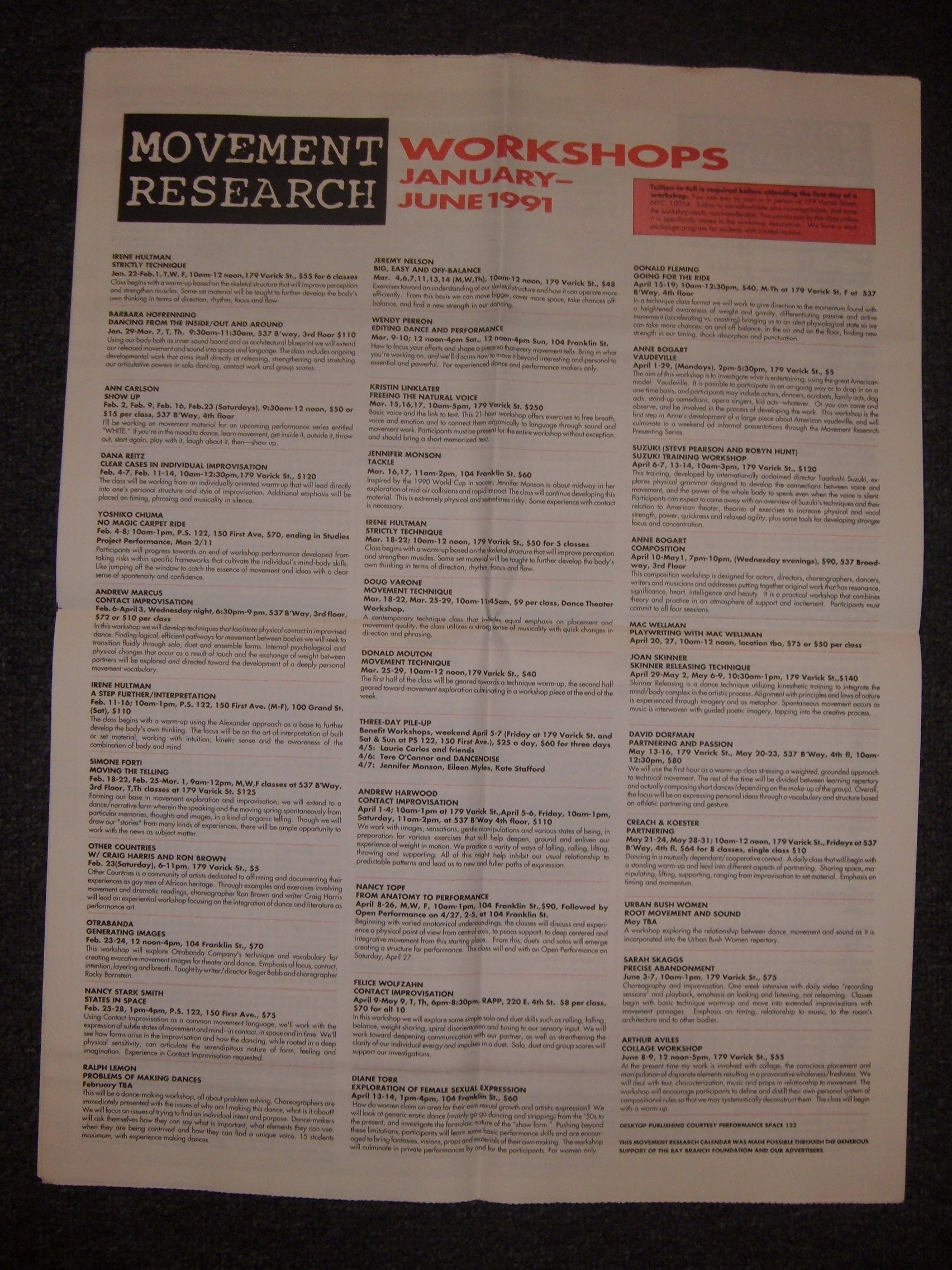Critical Correspondence
- MRPJ
- 1 comment
- MRPJ Project
- 9.26.08
MRPJ#2/Untitled: Editors’ Note
Editors: Richard Elovich and Guy Yarden
This is an encouragement towards collectivization within the performing arts community. It involves redefining the term “alternative” and committing ourselves to be more participatory, more radically democratic and accessible and less reliant on traditional modes of organizational leadership. The unique action that an alternative space can effect is direct involvement with the community. The gap between administration, audience and artist has yet to reach that stage of detachment that exists in mainstream institutions—where a direct mail letter is as close as you get. Why not see the inherent intimacy of the alternative space as a powerful resource?
For example, let’s look at the range of responses of our presenting organizations to A Day Without Art on Dec. 1, a day in which the arts community attempted to recognize the impact of the AIDS crisis. Should we have responded in ways so similar to Lincoln Center or the Met? To be more specific: What is the impact of an alternative space closing for [a] day or pausing for a moment during a performance? Our marginal position within New York City’s culture suggests that such silence may carry little weight. Who did we consult in determining these actions? Could we have found more active and engaging responses by turning inward and involving the members of our community? Reports suggest that many people perceived A Day Without Art as institutions’ responses to the AIDS crisis and did not feel compelled to respond through individual or non-affiliated action. Instead of choosing the middle ground occupied by most organizations, could the performance community have represented itself in a more radically inclusive manner on Dec. 1?
Are there any truly community events—“holy days”—for the performance arts? The largest gathering of performers in the city comes together for the annual “Bessies” Awards, an event shaped not by the community but by administrators and critics. This isn’t a slam on that ceremony, but should that be our only town meeting?
As members of the dance and performance world, we should get wise: audiences are shrinking; artists themselves are going to fewer performances; and we hear over and over that dance is tired and that performance art has run its course. Spaces are rarely “Hitsville” where a single weekend of performances can launch a career. When a Voice Choice no longer has the automatic effect of guaranteeing an audience, we no longer need to be slaves of the media, spending so much of our resources on promotion that no one bothers to read. Accepting that we are marginal—alternative, we could create our own standards and agenda. Five years ago audience members, many of them artists, could attend as many as three performances a week, which is for most of us no longer a possibility due to escalating ticket prices and an economy in recession. How are we building upon and caring for our audiences, making them vital to the realization of our work and the life of our spaces?
Are presenting organizations in competition with one another? How do alternative spaces relate to each other? Competitively? Cooperatively? How can performance spaces relate to visual arts spaces, which are often more effectively organized politically? How do alternative spaces relate to other non-art related community spaces? Rather than reconciling ourselves to being the minor or “bush leagues” of the NYC performance world, how can we have a radical effect on the more commercial spaces? In searching for the answers to these questions we can arrive at a new understanding of what we are as a community.
What are we talking about when we address issues of racism and sexism through “community outreach”? Does the programming of artists who are women, “people of color”, gays and lesbians actually involve these communities? Do organizations engage in tokenism to fulfill quotas and maximize their fundability? How do we begin to undo years of marginalizing in the arts community and beyond? Is it an arts organization’s responsibility to solicit involvement from other communities? Are artists, curators, administrators and board members prepared to relinquish or share control?
Artists in the eighties boom often formed their own companies (501c3 organizations) and took on the challenge of being “business-like:” taking on their own aggrandizement, promotion, grant writing, forming boards, organizing benefits. Artists now work predominantly outside of the traditional dance or theater company relationship. We can no longer afford the myth of “the artist as the ultimate individual who has to work alone.” Artists must stop allowing themselves to be infantilized, seeing other people in parental roles in relationship to them. We must take on the role of community and arts activists. We must become responsible to and for our community.
Could artists’ spaces become community centers? Places where members of the community could hang out… changing the interaction between artists, audience and administrators… redefining the traditional roles of these groups?
The work that we put into our community organizations now will dictate the type of community that will be around in the next ten years. This is an investment in ourselves.
Richard Elovich and Guy Yarden

reprint of image from MRPJ #2



post a comment ›